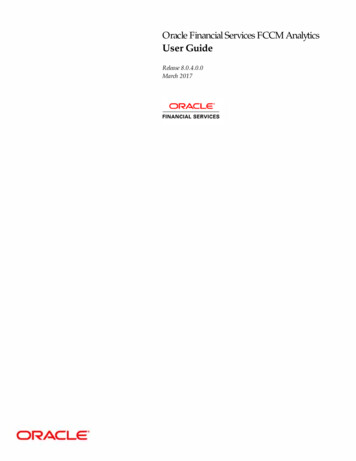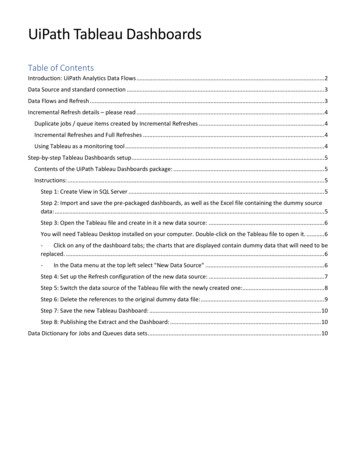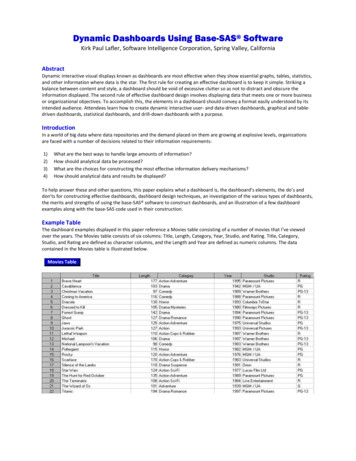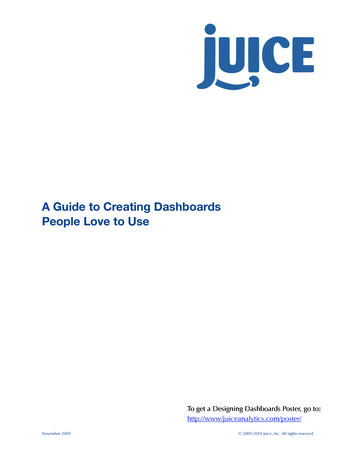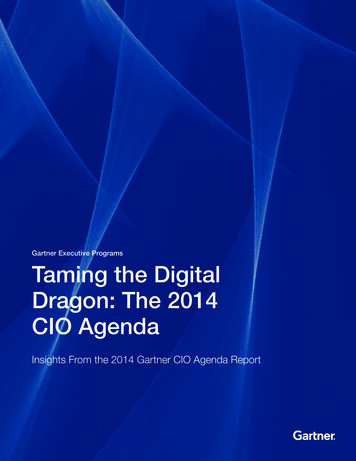
Transcription
White PaperExecutive Dashboards:Elements of SuccessApril 2009www.novell.com
Dashboards: the Complete Picture for Business and IT. 3Dashboards: Lessons Learned. 3Characteristics of a Successful Dashboard . 4Implementing a Successful Dashboard Project . 8A Dashboard Case Study: Online E-Card Retailing . 9Leveraging Novell for a Successful Dashboard Project. 11p. 2
Dashboards: the Complete Picture for Business and ITManagement dashboards have risen to the top of business and IT priority lists in recent months—and for goodreason. Dashboards have become an essential enabler in sustaining a highly competitive business. Why? Quitesimply, by consolidating essential IT service quality metrics, key performance indicators (KPIs), and businessprocess health into one interactive view, dashboards provide a real-time and historical window into overallbusiness performance. What’s more, because dashboards can also provide actionable information, business andIT managers can more effectively manage the areas of business for which they are responsible.This is especially necessary in today’s post-Enron business environment where business and IT managersare being held to higher levels of accountability. In response, top executives are mandating dashboard projectsto deliver meaningful visibility not only into business performance, but also into government regulatorycompliance.For companies rushing to outsource business processes or entire IT operations, dashboards provide aneffective means to monitor, measure and report on the quality of services provided by an outsourcer. For manyIT organizations, communicating the level of IT service quality delivered to the business has become a means ofsurvival—if IT can demonstrate that it’s providing a high quality service, there’s no need to consider outsourcingas an alternative. For these companies, dashboards provide a mechanism to communicate the business valueprovided by IT.In all cases, dashboards provide an effective means to empower business and IT management withaccurate, real-time and historical information necessary to running a successful and competitive business.However, many dashboard projects falter when they fail to link critical business metrics with IT performanceresults and are unable to present a “complete picture” of a business process or service. Without an actionable,relevant, end-to-end view of the complete business service based on real-time information, IT and businessmanagers are simply flying blind.In this white paper, we’ll investigate the characteristics and metrics of successful dashboards as well assuccessful dashboard projects within today’s business-centric enterprise. We’ll also discuss how Novell can helptoday’s companies design, develop, and deploy successful dashboard projects.Dashboards: Lessons LearnedDashboards are not a new concept; in fact, they’ve been around for nearly twenty years. According to ForresterResearch, dashboards are in their third incarnation, having evolved from executive information systems (EIS) ofthe 1980s and dashboards/cockpits of the 1990s. EIS mechanisms were intended to be extensions of thereporting systems in use at the time, targeted at executives who had little time to peruse the large volumes ofprinted operational reports being generated by the IT organization.Scorecards (sometimes referred to as Balanced Scorecards) played an important role in the evolution ofdashboards, according to Forrester. Although scorecards tend to be more rigorous than the average corporationcan accomplish, many practices established by scorecards have found their way into the less rigorous practicesof dashboards. In particular, poor dashboards are shallow representations of data out of context, whereasscorecard methods taught us that data must be seen in its appropriate business context. Relationships learnedp. 3
from scorecards reveal that measures roll up into metrics, which roll up into KPIs, which (in someimplementations) role up into Norton/Kaplan-like perspectives.So what have we learned from over twenty years of experience in building dashboards for executives and ITmanagers? First, dashboards are needed across all areas of the business—from IT operations and ITmanagement—to virtually all lines of business. In fact, according to Glenn O’Donnell from Forrester Research,“Business leaders demand quantifiable, objective evidence that their IT investment is bringing business value.”Obviously, the business executive has little interest in looking at the technology-centric world of ITmanagement or IT operations. Executive dashboards today must present a more balanced view of business andIT. Executives want to know how IT is affecting their business—not whether a Web server in the data center ishaving a disk problem again. The opposite is true for IT operations and IT management staff who need a muchmore technology-focused view. Figure 1 shows not only the pervasiveness of dashboard usage, but alsodemonstrates what role business and IT information has for each end user within the enterprise.Figure 1: The Pervasive Use of DashboardsDashboards of the past have failed because they were too IT-centric, too static, too hard to use, or becausethey lacked a role-based view. Today’s dashboards not only provide more balanced content, they’re also moreintuitive and interactive—and, just as importantly, they visualize business success or failure in real time. Goneare the days of the weekly or monthly report. Executives want “real-time reporting of IT’s business impact andmust be presented in business language,” according to O’Donnell.Characteristics of a Successful DashboardToday, dashboards are used for a variety of applications. From real-time and historical monitoring of criticalbusiness KPIs to monitoring of essential business processes, dashboards are used in all phases of business andIT service processes. Key examples include supply chain, order processing, inventory tracking, online tradingoperations, even monitoring of IT outsourcers themselves.In virtually all cases, effective dashboards incorporate the right balance of technical and businessinformation integrating relevant data extracted from existing systems and data bases. When building adashboard from scratch, it’s important to start with a few relevant metrics, establish a successful dashboardp. 4
prototype, and then build from there. It’s important to get actionable information into a “single pane of glass”format. Actionable dashboards have the following characteristics: The end user can interact with the dashboard to drill down into more detailed information The end user can issue commands to remediate problems or notify appropriate parties The end user can discover root case or impact analysis The end user can reallocate resources when neededWhen deciding upon which business metrics to incorporate, teams should choose those metrics that linkback to strategic initiatives within the company. In fact, in a recent survey conducted by Forrester Research of 22early-adopter, billion dollar firms, C-level sponsors clearly echoed this sentiment and listed the following metricsas most closely aligned to their business strategy and therefore, most important to their dashboard environment.Not surprisingly, the list included: Sales Orders Profit Call volumes Expenses Forecasts Inventory Customer satisfaction Average order size Lost sales Project milestones Shipments ProfitHowever, business metrics alone provide only half of the equation. What’s missing is the health of IT andhow it is affecting the state of the business. Without this side of the equation, executives don’t have a clearpicture of business health. What’s needed is the integration of critical IT service factors that have an impact orinfluence upon dashboarded business KPIs. In fact, among Global 2000 businesses today, IT services havemore impact on business performance than any other business factor, fraudulent behavior aside. In large part,because IT services have become so interwoven into our daily lives, as business agents, that high quality ITservice quality is directly proportional to successful business performance. For example, just six years ago,Fidelity Investments processed about 90 percent of its online trades over the phone, while a meager 10 percentwere conducted via the Internet. Today, these numbers are completely reversed, and system outages for Fidelitytranslate to substantial amounts of lost revenue.By adding in the right mix of IT service metrics, business and IT executives have an effective means toinstantly gauge business success. IT metrics that are meaningful to both IT and business; assimilate well withestablished business organizations; and clearly supplement the business metrics previously mentioned include: System availability End-user response time Transaction volumesp. 5
Mean-time-to-repair SLA complianceThere are several ways that today’s dashboard projects will be dramatically different than the previous twoincarnations and why they will achieve a far greater level of adoption throughout the enterprise. One way islinking all of these metrics back to their business owners and action takers to formulate dashboards that arecustomized to individual roles within the business.One other difference between today’s dashboards and those of even five years ago is the amount ofactionable data that is presented on the dashboard itself. According to Forrester Research, a key facet ofsuccessful dashboards today lies in their inherent interactive nature. The capability to drill down from summarydata to detailed data offers executives and IT managers alike a powerful mechanism to perform root causeanalysis of problems that have surfaced within the business. That’s not to say that executive managers will need,or want, to drill down into specific application or device alarms to determine the specific cause for poorperformance or system unavailability. However, it’s perfectly reasonable for an executive to drill down into ageographical depiction of business applications running across the country to find out exactly which application isimpacting the business and whether it’s because of availability or performance. This will become clearer as weillustrate some examples.Let’s start with the customer dashboard depicted in Figure 2, which shows a consolidated view oftelecommunications services provided by Verizon Business to its outsourcing customers.This dashboard viewintegrates informationessential for a number ofdifferent end users, from ITmanagement and operationsto Verizon Business end usersthemselves. Dashboards,such as in this case, usuallybegin with some sort ofgeographic representation ofthe organization. Shown hereare six different paymentcenters across the country—and judging by its color, thereFigure 2: Verizon Business Customer Dashboardappears to be a problem inChicago.Moving to the pane to the left, the business manager has an effective view of critical accounts receivablebusiness metrics—in this case, taken in real time from an existing ERP system. And to the left of that, otherbusiness metrics show the health of payment center “business” from key perspectives important to the business,such as volumes and suspect accounts. Finally, the bottom pane shows detailed health of the accountsreceivables process itself, integrating both business process and IT service metrics. The IT metrics themselvesp. 6
were integrated from a Business Service Management (BSM) software solution that provides real-timeperformance and availability information to the dashboard environment.In this way, it’s easy for the business manager to see that there’s a problem with the approval securitysystem—a problem that is, in turn, causing a bottleneck that prevents information on receivables to flow throughthe remaining process steps in the cycle.Today, IT managers and operations personnel are also using dashboards to get an accurate real-timeperspective of IT service health. Take the case of an IT manager responsible for ensuring high availability for anumber of critical applications within a global financial institution—applications that include, among others, anonline trading application.The dashboard in Figure 3 shows a view of service level health for each major IT and business processcomponent of this critical application. These process components include Internet access, service providers,authentication and data center processes. It’s easy to see from this view that there’s trouble in a CICS regionlocated within the data center. Real-time alarms at the bottom of the screen provide more detailed analysisinformation.By drilling down into the CICS region problem, the IT manager can get an even more detailed view ofexactly where outage, availability, and SLA compliance problems have occurred over the past week. In this case(see Figure 4), we’ve isolated the problem down to the Siebel application running in this CICS region. It’s clearthat we’ve had problems with SLA compliance on four separate days this week and judging from the indicatorsfrom the central site data center it looks like there’s a problem in the Web server farm. Further drilldown andanalysis will allow us to confirm this finding.Figure 3: IT Management View ofBusiness ProcessFigure 4: IT Management View ofApplication StatusIn summary, there are essentially six key characteristics of any successful dashboard: It must include a balanced view of both business and IT metrics customized for the role of the end user usingthe dashboard. This may include a business executive, an IT manager or IT operations personnel. The metrics integrated into any dashboard view must include business metrics that link to strategic businessmeasurement KPIs—whether for an application or a business process itself.p. 7
Any successful dashboard must also include relevant, real-time IT metrics that show the impact to thebusiness KPIs being monitored. This is the only way the dashboard user will have a complete understanding ofhow IT services are impacting business KPIs. Dashboards must not only have real-time information, they must also incorporate an intuitive and interactiveinterface allowing the end user to drill down into relevant and important root cause information. Dashboard design and development tools must support fully customizable dashboard views that are tailored toindividual end-user roles. At the IT manager and IT operations level, dashboards should also include real-time actionable informationthat allows users to issue relevant commands to the systems and applications being monitored.Implementing a Successful Dashboard ProjectVirtually all successful dashboard projects rely upon a series of essential characteristics, without which,fundamental dashboard usefulness is lost. These characteristics begin with the information upon which thedashboards are based. Without an integrated, real-time view of applicable IT and business metrics—such asthose provided by a BSM solution from Novell—it’s impossible to put together the balanced view that we’vediscussed in previous sections. Without real-time access to both the business and the IT metrics alreadymentioned, executives and IT managers are missing essential knowledge necessary to make accurate, timely,and proactive business or IT decisions. We’ll see in a later section, through a real-life example, just howimportant an integrated real-time view of IT and business really is.Are there other technologies besides BSM from Novell that can provide the same integrated view thatexecutives need? Of course, but when you consider the amount of time, effort, and resources required to pulltogether the necessary information—business KPIs, IT systems management, asset and configuration data—it’sclear why more companies are turning to Novell for BSM today. Not only does Novell technology provide amore effective and efficient means to integrate both IT and business metrics, it also visualizes this information ina consolidated view as a business service. This allows executives and IT managers to see exactly how ITservices are affecting the business.Once critical integration technology is in place, a successful dashboard project begins with a prototype thatis developed from a vision or evolved from examples of existing dashboards. Dashboard projects will then evolvein an iterative fashion, changing frequently (in some cases, every 30 to 60 days), to keep pace with changes inbusiness rules and new sources of data.Leveraging the vast experience of Novell will accelerate the prototyping process because we’ve had practicein implementing many dashboard projects for both business and IT organization all over the world. In addition,Novell can act as a catalyst to further accelerate the dashboard development process even beyond theprototyping phase, in large part, due to the faster turnaround times we can provide when changes are needed.Does this mean Novell professional services are necessary for all dashboard projects? The obvious answeris no; however, most companies will look to software vendors, like Novell, to help with at least initial dashboardprototypes simply to leverage key expertise and ensure that projects get off to the right start.According to Forrester Research, dashboard projects should be launched by a line-of-business processowner like a vice president of customer service or sales. This is because many early dashboard initiatives wereso heavily focused on data and how to report the results of queries interactively that the idea of aligning themetrics with business processes—and specifically, the owner of the metric—was not even considered.p. 8
To ensure the needs of the business are properly met, dashboard projects should have a businessexecutive project head. Just as importantly, dashboard project teams should be limited in size, but should includerepresentation from the business lines as well as from the IT organization. No matter who ultimately implementsthe dashboards defined by the project, it’s essential that there is key representation from both the end users aswell as the information providers (this is usually the IT organization).A Dashboard Case Study: Online E-Card RetailingFor any online retail business, high performance and 24X7availability are critical factors to success—both for theIT service organization as well as for the lines of business who are ultimately responsible for the business bottomline. How many times have we read in the newspaper about an e-tailer whose Web site went down during peakbusiness traffic, costing the company millions of dollars in lost revenue opportunity?On February 14, 2005, the list of companies grew by one more: a major greeting card manufacturer trying tocapture a part of the fast-growing online greeting card market. According to Reuters, “users seeking to pick up orsend electronic cards were turned away from the company’s site, which was offline for a large part of the1day. “We thought we were ready to handle a huge amount of traffic on Valentine’s Day, we thought wrong,” thiscompany wrote to its clients saying the Web was flooded by double the expected traffic.Had this company leveraged an integrated BSM solution featuring IT and executive dashboard visualization,many of the problems it experienced that day might have been avoided. To see why, let’s start by taking a look atsome of the critical factors that probably came into play.Let’s assume, for the sake of argument, that Web server capacity was an issue; there simply wasn’tsufficient IT infrastructure to handle the peak loads of that day. However, adding more Web server capacitydoesn’t completely solve the problem. Going forward, what’s to prevent this company from reliving the samesituation because traffic grew beyond expectations, yet again? Next time, the blame shouldn’t rest with IT; itshould reside squarely on the shoulders of business management who, on February 15, 2005, should havedemanded better visibility into IT services and its impact on the business.One thing remains perfectly clear: The only things separating future success from failure will be sufficient ITinfrastructure capacity, combined with more effective IT service management controls, and coupled withcomprehensive visibility into IT services via executive and IT management dashboards. Let’s walk through ascenario much like what this company experienced on February 14. We’ll assume a more robust infrastructureand we’ll further assume essential processes are in place to balance workloads, given sufficient lead-timethrough real-time visibility into IT service quality.For simplicity’s sake, we’ll call this company MyCard.com.MyCard.com—Online E-Card Retailing: A Fresh ViewIt’s 11 o’clock in the morning on Valentine’s Day. The vice president of sales for MyCard.com arrives in his NewYork corner office and turns on his laptop to get a better picture of online business. Opening his executivedashboard view of the online shopping system he sees the following:1.Reuters, February 16, 2005p. 9
The business indicators depicted in the geographic map of the three major data centers across the countrytell a disturbing story: Revenue is off substantially for the East Coast. At the bottom of the screen it’s easy to getthe business story behind the fall in revenue. The login rate of users trying to gain access to online shopping isdown. Login rate is considered a leading indicator because, in this case, it portends lower order rates. The nextindicator is the cart abandonment rate—the rate at which potential customers are abandoning the items they’veselected to purchase before completing their online transactions. An executive in this position would certainlywant to find out why customers are abandoning carts at an abnormally high rate. He doesn’t need to look far—the online order rate is lower than expected, and the online customer satisfaction rate (the most lagging of theseindicators) is only marginally acceptable.The culprits for these problems are easy to spot, especially in this integrated view of business metrics and ITservices. By looking at the IT service indicators depicted on the right window pane, it’s easy to see why thisonline system is experiencing problems. The firstindication is system availability, which is down fromwhere it normally should be. The next indicator ismore telling: Transaction volume is way up fromwhere it normally is, as shown by the “red” pre-setindicator. This is to be expected on Valentine’s Day,but given current levels and the time of the day,there will surely be capacity issues before this day isthrough. Problems are especially likely, especiallybecause the third indicator represented here, systemresponse time, is running far below acceptableFigure 5: Executive Dashboard– MyCard.comlevels.Sensing an impending re-occurrence of historicalevents, the sales executive calls the lead analyst of IToperations to discuss the situation. The analyst listensto the problems sales has encountered andimmediately pulls up her view of IT services— an ITmanagement dashboard, which looks something likefigure 6.With one glance at her management dashboard,it’s evident to the analyst that this problem is not goingto get better unless immediate action is taken. Thebusiness views in the upper half of the dashboardFigure 6: IT Managers DashboardMyCard.comdepict a business process scenario that puts thebottleneck in the area of the East Coast Web servers. Without re-balancing the load from East-Coast to WestCoast servers, Web capacity will soon be exhausted. Alerts at the bottom of the screen confirm the bottleneckand the analyst initiates the commands necessary to “swing” Web site traffic from East Coast to West Coastservers, thereby removing capacity issues and bringing response times back into line.p. 10
Leveraging Novell for a Successful Dashboard ProjectFor years, Novell has provided the technology and professional services necessary to global organizations toexecute successful dashboard projects. During this time, Novell implemented many dashboard projects across awide array of vertical industries for both lines of business and IT organizations alike. In fact, all of the dashboardexamples presented in this white paper were modeled after actual customer implementations.Each of the dashboards represented here rely upon a complex integration of network, systems, orapplication management; and asset or configuration data; combined with some form of business information toprovide a complete picture of business health. One of the fundamental core competencies that Novell brings tothe table is a robust suite of integration capabilities. Through BSM technology from Novell, integrating your BMC,IBM, HP, CA, Mercury, Micromuse, NetIQ, CiscoWorks or other management system environment into onecentralized dashboard view is fast, easy and maintainable. Further, with our BSM technology, integratingbusiness metrics from virtually any flat file or relational data source gives executives and IT managers alike aclear and concise view of their business in the context of exactly how IT services are impacting businesssuccess.Having the right integration technology without a complimentary visualization capability is like having aninstrument panel on an airplane but no window to see outside. The instruments provide instant understanding ofposition and will get the pilot to the runway, but without a clear view of the final goal, a successful landing is notpossible. Having dashboard visibility into IT services as they relate to the business is only useful if executivescan intuitively and instantly understand the metrics in the context of their larger goal—achievement of KPIs forinstance. This often requires a complex blend of customized views tailored to individual end users. Novellintegrated dashboard capabilities allow users to implement complex and customized dashboard solutionsthrough simple point-and-click operations—no scripting is required. Our professional services team has the skilland knowledge needed to assemble exactly the right components and content to build custom-tailored viewsaround specific, role-based configurations.Combining Novell technology with our industry-leading services provides the needed assurance of asuccessful dashboard project. Not only has Novell Services established a long track record of successfulimplementations, but, in doingso, we have built an extensiveknowledgebase that can beleveraged to acceleratevirtually any dashboardproject while lowering risk andimproving the chances of asuccessful rollout andadoption among end users.Figure 7 depicts theNovell dashboard projectdevelopment lifecycle. Asrecommended in earlierFigure 7: Novell Dashboard Project Lifecyclesections of this paper, thep. 11
lifecycle begins with a prototype—one developed from an existing project, an initial vision, or borrowed from thewide variety of dashboards implemented by Novell. In this phase, interviews with end users are conducted tounderstand how dashboards will be used and which relevant metrics are required for successful business or ITmanagement. The initial design phase is possibly the most critical phase of any dashboard project. It is here thatearly designs can either succeed with early adopters or fall by the wayside like so many other failed projects. It iscritical to have the experience and understanding to know how and why end users use dashboards, as well as tounderstand exactly what content they need to see for their particular role in the company.With a clear vision defined for the initial prototype, developing it is usually accomplished in a short period.Novell facilitates all phases of project development, from design, to implementation of critical metrics, to craftingcustomized role-based views for end users. We work closely with you throughout the dashboard developmentlifecycle to ensure that your project is tailored to your specific needs, and that your dashboards are effective andefficient.For those companies looking for an experienced vendor capable of providing the technology, services andexperience necessary to deploy a successful dashboard project, Novell is a perfect one-stop source.Copyright 2009 Novell, Inc. All Rights Reserved. Novell, the Novell logo and the N logo are registeredtrademarks of Novell, Inc. in the United States and other countries. *All third-party trademarks are the propertyof their respective owners.462-002115-001p. 12
today's companies design, develop, and deploy successful dashboard projects. Dashboards: Lessons Learned Dashboards are not a new concept; in fact, they've been around for nearly twenty years. According to Forrester Research, dashboards are in their third incarnation, having evolved from executive information systems (EIS) of
